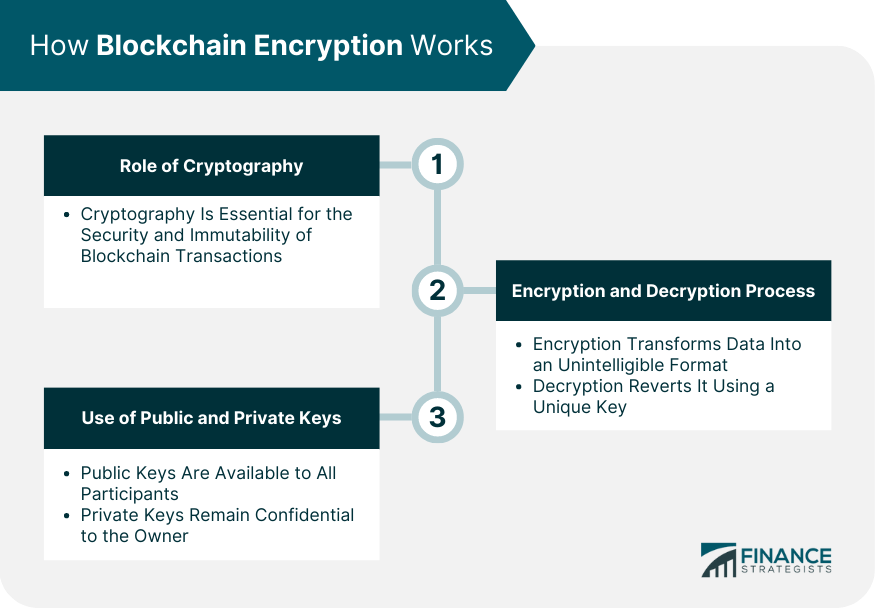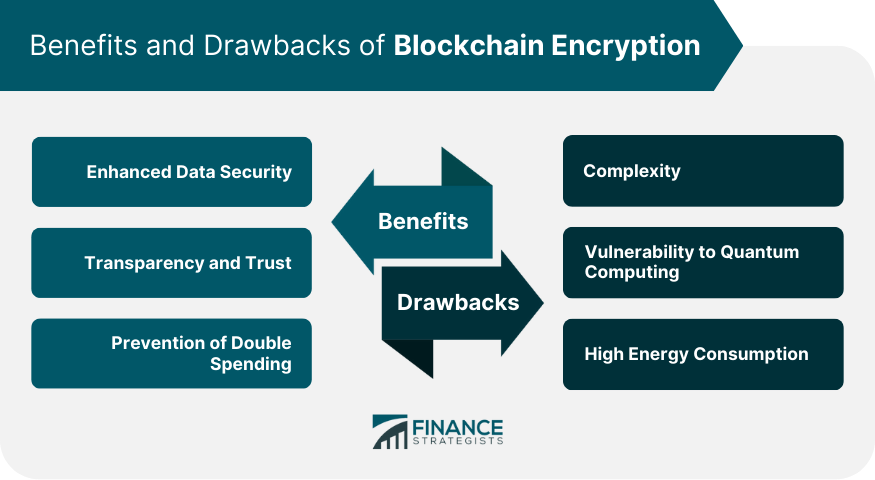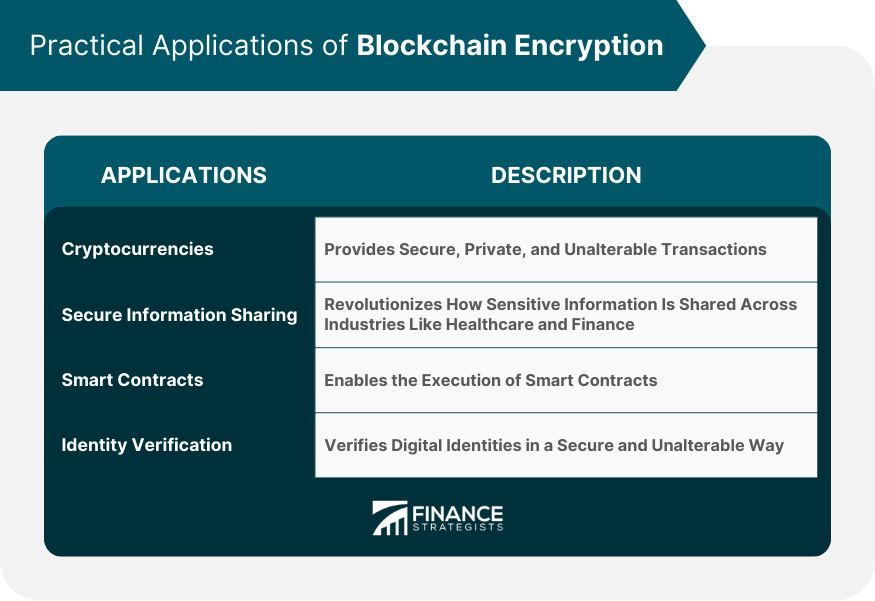Blockchain encryption is a crucial component of blockchain technology that ensures the security, privacy, and immutability of data recorded on a blockchain. It is a method by which data is converted into a code to prevent unauthorized access. The purpose of blockchain encryption is to maintain the integrity of the data and to provide a secure and transparent environment for transactions. This technology has a significant impact on readers, as it underpins the security of digital currencies like Bitcoin and is increasingly used in industries such as healthcare, finance, and governance for secure information sharing. Blockchain encryption brings unprecedented levels of trust and security to digital transactions, enabling the secure exchange of information in a decentralized and transparent manner, and is thus integral to many aspects of our increasingly digital lives. Cryptography is the backbone of blockchain technology. It is responsible for the security and immutability of transactions that take place on the blockchain. Each transaction is digitally signed using a pair of private and public keys, a process known as asymmetric cryptography. This ensures that only the person who possesses the private key can initiate a transaction, providing a layer of security and trust. In a blockchain network, encryption transforms the original data into an unintelligible format before it's sent across the network, preventing unauthorized users from understanding the information. Once the encrypted data reaches the intended recipient, it can be decrypted using a unique key. This ensures that only the participants of the transaction, who have the right decryption keys, can access the content of the transactions. Public and private keys play a crucial role in blockchain encryption. The public key is available to all participants in the network, while the private key remains confidential to its specific owner. When a transaction is initiated, it is signed with the private key of the sender. This transaction can be verified by anyone in the network using the sender's public key, ensuring the integrity and authenticity of the transaction. One of the most significant benefits of blockchain encryption is the enhanced security it brings to digital transactions. The use of encryption ensures that data cannot be tampered with or altered. It ensures that even if the data is intercepted during transmission, it cannot be deciphered without the unique decryption key. Blockchain encryption offers a high level of transparency while maintaining the privacy of the participants. All transactions are recorded on the blockchain and can be audited, promoting accountability and trust among network participants. Blockchain encryption plays a crucial role in preventing double-spending, a common problem in digital currencies. Double spending occurs when a person spends the same digital currency multiple times. Blockchain's cryptographic functions ensure that each transaction is unique, preventing double-spending. The encryption process in the blockchain is complex, and understanding it requires a deep knowledge of cryptography and computer science. This complexity can be a barrier to widespread adoption and usage. While blockchain encryption provides robust security, it's theoretically vulnerable to quantum computing attacks. Quantum computers have the potential to break the cryptographic algorithms used in blockchain encryption. However, this threat is more theoretical than practical, as quantum computers are not yet powerful enough to break blockchain encryption. Blockchain encryption, particularly in systems that use proof-of-work consensus algorithms, like Bitcoin, requires significant computational power and energy, leading to high energy consumption. This has led to concerns about the environmental impact of such systems. The most popular application of blockchain encryption is in the realm of cryptocurrencies, like Bitcoin and Ethereum. Blockchain encryption ensures that transactions are secure, private, and cannot be altered, making digital currencies a reliable and secure medium of exchange. Blockchain encryption has revolutionized the way we share sensitive information. Industries such as healthcare and finance can securely share sensitive data, ensuring that only authorized parties can access it. Blockchain encryption plays a crucial role in the execution of smart contracts. These self-executing contracts run on the blockchain, and their terms are written into code. Blockchain encryption ensures that these contracts cannot be altered once deployed, bringing unprecedented levels of trust and security to digital agreements. With blockchain encryption, digital identities can be verified in a secure and unalterable way. This has applications in various sectors, including banking, governance, and even voting, where identity verification is critical. Despite the challenges, there is ongoing research to enhance the security and efficiency of blockchain encryption. For instance, quantum-resistant algorithms are being developed to secure blockchains against potential quantum computing attacks. Moreover, newer and more efficient consensus algorithms are being explored to reduce the energy consumption associated with blockchain encryption. Technologies like proof-of-stake and delegated proof-of-stake promise the same security as proof-of-work but with a fraction of the energy usage. Blockchain encryption underpins the security and integrity of data within blockchain technology. It employs complex cryptography, using public and private keys to secure transactions and prevent unauthorized access. While its advantages include enhanced data security, transparency, and prevention of double-spending, it also has its share of challenges, such as its complexity, potential vulnerability to quantum computing, and high energy consumption. Nevertheless, it is the bedrock of various applications such as cryptocurrencies, secure information sharing, smart contracts, and identity verification. As the technology matures, future developments are expected to address its current limitations, paving the way for a more secure and energy-efficient blockchain encryption mechanism. The evolution of blockchain encryption continues to shape the digital world, providing a safer and more transparent avenue for digital transactions.What Is Blockchain Encryption?
How Blockchain Encryption Works
Role of Cryptography in Blockchain
Encryption and Decryption Process
Use of Public and Private Keys

Benefits of Blockchain Encryption
Enhanced Data Security
Transparency and Trust
Prevention of Double Spending
Drawbacks of Blockchain Encryption
Complexity of the Encryption Process
Vulnerability to Quantum Computing Attacks
High Energy Consumption

Practical Applications of Blockchain Encryption
Cryptocurrencies
Secure Information Sharing
Smart Contracts
Identity Verification

Future Developments in Blockchain Encryption
Conclusion
Blockchain Encryption FAQs
Blockchain encryption is a crucial aspect of blockchain technology that ensures data security, privacy, and immutability. It's a process that converts data into a code to prevent unauthorized access.
Blockchain encryption works by using cryptography. Each transaction is digitally signed using a pair of private and public keys, ensuring security and trust. Encrypted data is sent across the network, and only those with the correct decryption keys can access it.
Blockchain encryption enhances data security, promotes transparency and trust, and prevents double-spending in digital currencies. It ensures that data cannot be altered and if intercepted, cannot be deciphered without the correct key.
The encryption process can be complex and requires a deep understanding of cryptography. It's theoretically vulnerable to quantum computing attacks and can lead to high energy consumption, especially in systems that use proof-of-work consensus algorithms.
Practical applications of blockchain encryption include cryptocurrencies, secure information sharing, smart contracts, and identity verification. These sectors benefit from the enhanced security and trust that blockchain encryption brings.
True Tamplin is a published author, public speaker, CEO of UpDigital, and founder of Finance Strategists.
True is a Certified Educator in Personal Finance (CEPF®), author of The Handy Financial Ratios Guide, a member of the Society for Advancing Business Editing and Writing, contributes to his financial education site, Finance Strategists, and has spoken to various financial communities such as the CFA Institute, as well as university students like his Alma mater, Biola University, where he received a bachelor of science in business and data analytics.
To learn more about True, visit his personal website or view his author profiles on Amazon, Nasdaq and Forbes.











